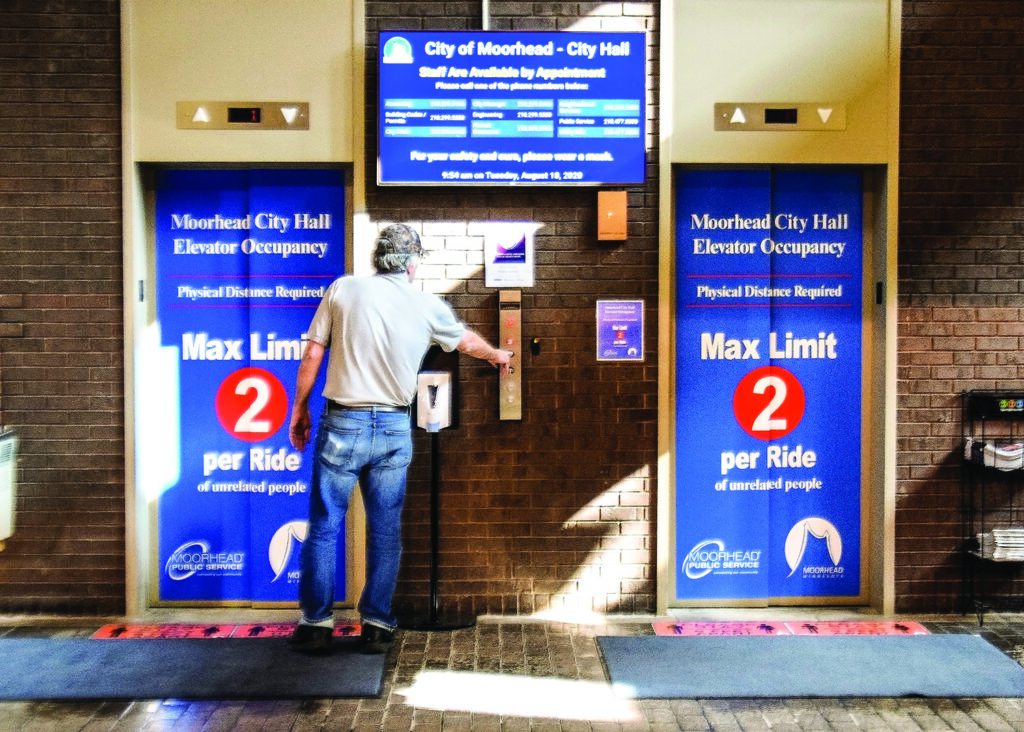
Access to the two elevators that serve four floors of office has complicated Moorhead city government’s COVID-19 precautions. To avoid crowding, public access to offices and meetings has been curtailed since mid-March. (Photo/Nancy Hanson.)
Nancy Edmonds Hanson
Moorhead’s city government is operating as usual … but those operations are spread all over the city.
Since mid-March, when Gov. Tim Walz issued executive orders prompted by the explosion of the novel coronavirus, city leaders and staffers have heeded state guidance on working remotely. Those who have normally come to work at City Hall, riding its elevators to four floors of offices that look over the city, were urged to consider “telework” – conducting their daily tasks from home via computers, cellphones and the internet.
That has meant a dramatic cut to the daily population in the downtown city headquarters. The city employs the equivalent of 294 men and women, all considered “essential” under the executive orders, but only a portion of them have desk jobs. A large proportion have jobs that take them out and about the city – police, firefighters, parks employees, sanitation workers, street crews. Others work in settings like the Water and Wastewater Treatment Plants, where there’s little or no contact with the public.
Of those who work in other agencies – from the city manager, finance and human resources to engineering, economic development and Moorhead Public Service – a good share are now dispersed throughout the city.
Governmental affairs director Lisa Bode is one of them. Like many of her colleagues, she has spent most of her time working from home since the governor’s orders in March. She says that 44 employees who normally inhabit the downtown offices are spending 100% of their time working from home. Another 38 are splitting their time between home and forays into City Hall. “I live five minutes away,” she notes. “I can run over whenever I need to pick something up or drop it off.”
When then-city manager Chris Volkers convened a command team of department leaders in March, the largest single challenge they faced – outside of the virus – turned out to be City Hall itself. Moorhead’s government headquarters was constructed in the early 1970s with no anticipation whatsoever that someday social distancing would make its multi-floor design problematic.
Only two elevators from the ground floor atrium provide access to – and within – four floors of office space. Most critical of all is the City Council chambers on the first floor (what others would assume was the second). Along with council members and city officials, the space occasionally draws a full house of citizens anxious to audit debates and offer their comments.
“The elevators are small,” Bode points out, “and guidelines limit them to two people at a time.” The alternative is 120 steps – 10 flights – from top to bottom. “That’s good exercise, but it has its problems, too,” she notes. “By the time you’ve climbed all the way up, you’re bound to be huffing and puffing – and that’s definitely not recommended under the circumstances.”
The city has worked around the elevators’ choke point by replacing public meetings held in person with online versions. Council meetings have been held in cyberspace since March, when virtual meeting technology offered a way for members to participate at a distance – and for citizens to view the meetings live on MCAT’s cable broadcasts and the city’s Youtube channel. The move to online meetings required an emergency declaration. Since then, other city commissions like Human Rights, Economic Development and Arts and Culture have also gone virtual. Citizens can offer testimony by telephone.
There’s been discussion of moving public meetings to a site in the Hjemkomst Center, where more space and better access could make a return to “normal” meetings possible. The cost could qualify under the $3.28 million in CARES Act funding received from the federal government and dispersed by the state. But, says Bode, the current focus on relief grants to businesses via the MoorheadCares.com website has moved other matters to the back burner.
The transition has been relatively easy for some of the displaced workers. Bode herself was already equipped with a laptop and online access to accommodate her travels to St. Paul and elsewhere in the state. For others, teleworking required additional hardware and secure internet access. Information technology director Chris Radi has worked with the remote-access system. He notes that private data remains securely on city-owned systems and is not being stored or processed on personal equipment.
In all, $78,000 of the city’s CARES grant has been earmarked to cover teleworking and related expenses.
Residents who have business with city officials can make appointments for face-to-face meetings, but impromptu encounters are ruled out. Front-line office workers stationed in bullpen settings are now separated by plexiglass barriers. Most business, though, is conducted by telephone or online video meetings. “We’ve been doing this for so long now that WebEx meetings seem more or less normal,” Bode observes.
Along the way, she says, some valuable lessons have been learned. “WebEx meetings do get things done,” she says. “So much of our business can be done remotely. I don’t really feel nearly as disconnected from my colleagues than you might expect.
“It’s the informal conversations that are missing.” She adds, “I feel badly for employees that have joined the organization in the past year. How challenging to get up to speed right now!”
Is there an end in sight – a return to normal operations? Not likely. “It’s been so many months now that this just seems like what we do. We miss seeing everybody in one place and the in-person customer service and communication, but business is getting done.
“One thing is for sure: Life isn’t going to be the same for some time.”


